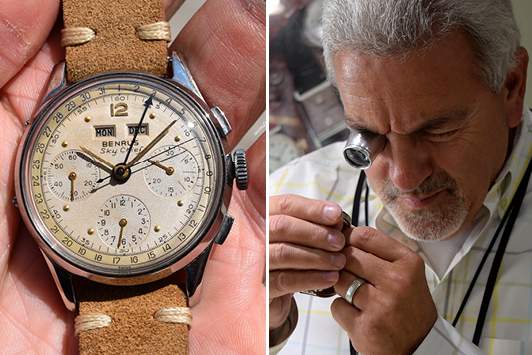
What are the key challenges of buying and selling
vintage/antique watches?
The greatest challenge is the same as it always has been, and that is being able to find and obtain the right inventory. There are fewer and fewer goods available, and prices have exponentially increased. Parts for vintage watches are limited and often difficult to obtain, as is a knowledgeable and qualified watchmaker to perform correct repairs and services. Since the pandemic, supply and availability of vintage watches has diminished, as many wholesalers have not been able to obtain inventory to sell, and suppliers have not been able to attend watch shows or hold or attend buying events.
Should purchases be limited to recognizable brands?
Every customer makes a personal choice when selecting a vintage watch. Some collect only by brand; some prefer selected movements, and others choose certain shapes. Each retailer’s customer base has its own unique interests and demographics, and that will dictate what is best to stock. Typical non-collector customers are initially drawn to a known brand name. Many vintage watches offer desirable movements, such as the Chronograph Valjoux 72 movement. For the Valjoux 72 collector, often the brand name does not matter, and lesser-known brands with these desirable movements can be obtained and sold at better prices, better values. In the older vintage segment, the shape and style often figure more in choices than brand name.
Is buying from the public a good way to source antique and vintage watches?
Buying directly from walk-in store customers or online listings by customers is one option. In our case, we have found walk-in sales are our most minimal source. Often we are presented with less desirable watches, or even counterfeit versions of desirable watches.
What are the signs of counterfeit watches? What are the pitfalls to look out for?
With technological advancements, the number of counterfeit watches has increased, becoming more sophisticated and making it harder to easily identify them. That said, there will always be at least one or more things a counterfeit watch has that identifies it as not authentic. Counterfeiters typically miss a few details, so you have to be very knowledgeable about the authentic version. In the vintage watch world, originality and condition are what matter most. Watches that have been overly polished or overly redone (dial, hands, bezels, etc.), or that show signs of extensive prior repairs, should be avoided.
What is the best way to build an audience?
While we remain focused on the vintage-watch niche, we have found that the audience is changing. Many younger customers are expressing interest in vintage watches, while many older customers are no longer collecting or purchasing. Social media, such as Instagram, seems to be a current method of building new as well as collector audiences. The key to deciding what inventory to carry is to know your customers and their preferences. The more popular brands are those that have produced the most watches, such as Rolex, Omega, Cartier, Hamilton, etc. In our case, since we have a very diverse customer base, there really are no brands, types or eras that are more popular than others.
Image: Second Time Around Watch CompanyArticle from the Rapaport Magazine - December 2020. To subscribe click here.